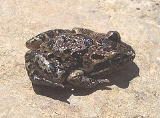
Long-thumbed Frog
Encyclopedia
The Long-thumbed Frog, Fletcher's Frog or Barking Marsh Frog (Limnodynastes fletcheri) is a species of ground dwelling frog native to southeastern Australia.
(Limnodynastes tasmaniensis) from which it can be distinguished by the larger irregular shaped blotches. The belly is white. The tympanum
is indistinct. It usually is 30 - 60mm in size.
of New South Wales
as well as southern Queensland
, northern Victoria and eastern South Australia
. It is associated with rivers, dams and creeks (often temporary) in woodland and grassland. During drier conditions they shelter under rocks, in cracked mud and yabby
burrows.
Males make a dog-like "rok" or "whuck" call from grassy areas around the edge of water bodies, after rain or when water levels are high, during spring to autumn. Breeding occurs mostly after heavy rain and eggs are laid in a floating foamy mass, often attached to vegetation. Tadpoles reach 69 mm and because it is an opportunistic breeder
metamorphosis can occur at any time of the year. The tadpoles are very similar to Limnodynastes tasmaniensis and cannot be readily distinguished until metamorphosis.
Physical description
The Long-thumbed Frog is a medium sized frog reaching about 50 mm in length. It is grey or brown with abnormal shaped darker patches or irregular spots, and in most individuals a butterfly-shaped patch between the eyes. There is normally a red or purplish patch above the eye. It is similar in many respects to the Spotted Grass FrogSpotted Grass Frog
The Spotted grass Frog or Spotted Marsh Frog is a terrestrial frog native to Australia. It is distributed throughout all of New South Wales and Victoria, eastern South Australia, the majority of Queensland and eastern Tasmania...
(Limnodynastes tasmaniensis) from which it can be distinguished by the larger irregular shaped blotches. The belly is white. The tympanum
Tympanum (zoology)
The tympanum is an external hearing structure in animals such as frogs, toads, insects, and mammals, to name a few.-Anurans:In frogs and toads, it is located just behind the eye. It does not actually process sound waves; it simply transmits them to the amphibian's inner ear, which is protected...
is indistinct. It usually is 30 - 60mm in size.
Behaviour and ecology
This species inhabits drier areas west of the rangesGreat Dividing Range
The Great Dividing Range, or the Eastern Highlands, is Australia's most substantial mountain range and the third longest in the world. The range stretches more than 3,500 km from Dauan Island off the northeastern tip of Queensland, running the entire length of the eastern coastline through...
of New South Wales
New South Wales
New South Wales is a state of :Australia, located in the east of the country. It is bordered by Queensland, Victoria and South Australia to the north, south and west respectively. To the east, the state is bordered by the Tasman Sea, which forms part of the Pacific Ocean. New South Wales...
as well as southern Queensland
Queensland
Queensland is a state of Australia, occupying the north-eastern section of the mainland continent. It is bordered by the Northern Territory, South Australia and New South Wales to the west, south-west and south respectively. To the east, Queensland is bordered by the Coral Sea and Pacific Ocean...
, northern Victoria and eastern South Australia
South Australia
South Australia is a state of Australia in the southern central part of the country. It covers some of the most arid parts of the continent; with a total land area of , it is the fourth largest of Australia's six states and two territories.South Australia shares borders with all of the mainland...
. It is associated with rivers, dams and creeks (often temporary) in woodland and grassland. During drier conditions they shelter under rocks, in cracked mud and yabby
Cherax
Cherax is the largest and most widespread genus of fully and partially aquatic crayfish in the Southern Hemisphere. Its members may be found in lakes, rivers and streams across most of Australia and New Guinea. In Australia the many species of Cherax are commonly known as yabbies...
burrows.
Males make a dog-like "rok" or "whuck" call from grassy areas around the edge of water bodies, after rain or when water levels are high, during spring to autumn. Breeding occurs mostly after heavy rain and eggs are laid in a floating foamy mass, often attached to vegetation. Tadpoles reach 69 mm and because it is an opportunistic breeder
Opportunistic breeders
Flexible or opportunistic breeders mate whenever the conditions of their environment become favorable. Their ability and motivation to mate are primarily independent of day-length and instead rely on cues from short-term changes in local conditions like rainfall, food abundance and temperature...
metamorphosis can occur at any time of the year. The tadpoles are very similar to Limnodynastes tasmaniensis and cannot be readily distinguished until metamorphosis.

